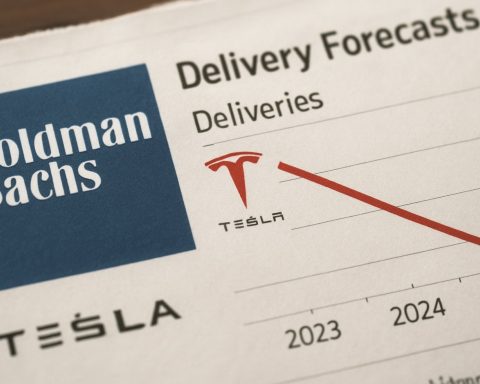- Restaurant Brands International reported a 21.3% year-on-year revenue increase, reaching $2.11 billion, slightly below Wall Street expectations of $2.15 billion.
- Earnings per share fell short by 4.1% from projections, rounding off at $0.75, with adjusted EBITDA at $642 million against an expected $671.5 million.
- The company expanded to 32,149 locations globally, driven by an 8.5% annualized revenue growth since 2019 and a strong franchise model facilitating a 3.8% annual location growth.
- Same-store sales remained flat last quarter, contrasting with prior growth of 4% annually over the last two years.
- Despite missing recent projections, Restaurant Brands maintains a significant market presence with a $22.24 billion market capitalization, leveraging brand loyalty and supply chain advantages.
Restaurant Brands International, the multinational giant steering Burger King, Tim Hortons, and Popeyes, has set a remarkable pace in the fast-food industry, yet their latest quarterly report offered a mixed bag of outcomes. The air was thick with expectation as Wall Street analysts predicted thriving numbers, but the reality was slightly underwhelming. One can’t help but wonder if this is a temporary lull or a harbinger of market shifts in the fast-food domain.
The company enjoyed a robust 21.3% year-on-year revenue surge, reaching $2.11 billion, yet it fell shy of anticipated figures. Analysts had pegged their hopes on a more generous $2.15 billion mark. This subtle shortcoming was mirrored in the earnings per share too, which saw a 4.1% dip from projections, rounding off at $0.75. The adjusted EBITDA also followed this near-miss narrative, revealing a gap at $642 million against expected $671.5 million.
Delving deeper, the strategic merger that formed Restaurant Brands International has proven its clout over the years, growing with annualized revenue rising by 8.5% since 2019. This growth is driven largely by expanding its footprint to a whopping 32,149 locations globally, thanks to an astute franchise model. This model decentralizes restaurant openings, letting franchisees drive the charge; a crucial maneuver that has led to a rapid 3.8% annual location growth rate over two years.
Yet, not all that sparkles is gold. The excitement of opening new venues now stands in contrast to a stark reality: same-store sales have stagnated over the last quarter. A compelling indicator indeed, for it was strong same-store sales which had previously signaled market enthusiasm and operational efficiency within established locations. The once flourishing same-store sales grew by an average of 4% annually over two years until this recent stall.
Navigating through these choppy waters, the question arises: Is it a tactical moment to invest in Restaurant Brands? The company holds a solid footing with a market capitalization of $22.24 billion, underpinned by an unparalleled loyalty nurtured through years of brand affinity. Restaurant Brands has utilized its scale to negotiate better terms with suppliers, ensuring competitive pricing on its offerings.
While the recent quarterly results didn’t light up Wall Street, the broader picture provides a tableau of resilience and opportunity. Restaurant Brands continues to expand and evolve, bringing its iconic flavors to more locations worldwide. The real takeaway here is the tale of a fast-food empire willing to expand aggressively while grappling with the nuanced pressures of the modern market. As they seek to reignite same-store sales and meet lofty financial aims, their journey remains a captivating narrative within the industry’s landscape.
Is Restaurant Brands International a Smart Investment Amidst Market Shifts?
Restaurant Brands International (RBI), the powerhouse behind Burger King, Tim Hortons, and Popeyes, recently revealed quarterly results that painted a complex picture: a significant revenue increase coupled with slightly disappointing earnings compared to Wall Street expectations. This performance raises essential questions about the company’s strategic direction, market adaptability, and investment potential.
Industry Trends and Market Forecast
1. Fast Food Industry Growth: Despite RBI’s recent earnings shortfall, the fast-food sector is projected to grow, fueled by increasing consumer demand for convenient dining options. According to Statista, the global fast-food market is expected to reach $931 billion by 2027.
2. Digital Transformation: RBI’s continued investment in digital channels offers a promising area for growth. Digital and delivery sales have surged across the industry, and enhancing technology-driven options can cater to a tech-savvy customer base.
Real-World Use Cases
– Franchise Model Efficacy: RBI’s franchise model allows rapid expansion by enabling local entrepreneurs to manage individual locations, thereby promoting local engagement and tailored customer experiences. This decentralization is crucial in adapting to diverse market conditions globally.
– Supply Chain Advantages: Leveraging its scale, RBI optimizes supply chain management, ensuring competitive pricing of raw materials. This strategy not only curtails costs but bolsters price competitiveness against peers.
Pros & Cons Overview
Pros:
– Global Presence: RBI’s worldwide reach gives it a strategic edge in international markets, reducing reliance on any single economy.
– Brand Recognition: Iconic brands like Burger King and Tim Hortons fuel customer loyalty and provide a stable revenue stream.
Cons:
– Stagnant Same-Store Sales: Recent stagnation in same-store sales growth poses a risk, indicating challenges in maintaining customer interest in established locations.
– Earnings Fluctuations: Missing Wall Street revenue predictions can affect stock prices and investor confidence.
Opportunities and Challenges
– Opportunities: Expanding into emerging markets with high-growth potential and innovating menu offerings cater to changing dietary preferences, including plant-based options.
– Challenges: Consumer health trends pushing for healthier food options could impact traditional fast-food brands’ sales unless they adapt.
Security & Sustainability
Sustainability Initiatives: RBI’s commitment to sustainability, such as reducing packaging waste and incorporating renewable energy, aligns with increasing consumer demand for responsible corporate practices. This can enhance brand reputation and long-term customer loyalty.
Actionable Recommendations
– Investment Insight: Investors should monitor RBI’s strategies to revitalize same-store sales, digital expansion, and new market entries. Long-term growth seems promising, but temporary market fluctuations require cautious investment.
– Customer Retention Strategies: Focusing on enhancing the customer experience through loyalty programs and personalized marketing can drive repeat business.
Conclusion
Restaurant Brands International showcases the complexities of maintaining growth and profitability in the ever-evolving fast-food industry. Despite recent challenges, its robust franchise model, international expansion, and focus on digital innovation position it well for future growth. Investors and customers alike should watch how the company adapts to industry trends and consumer preferences to determine its continued success.
For more insights into the fast-food industry, check out Restaurant Brands International.








